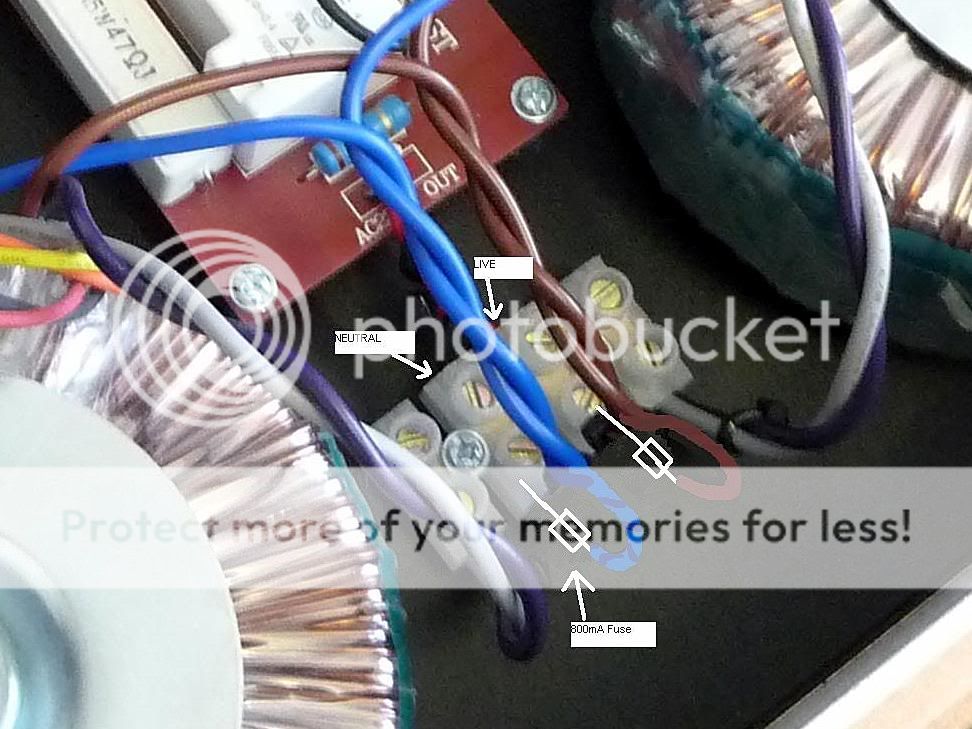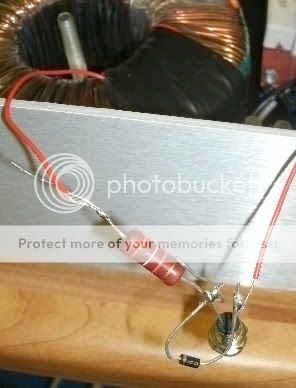a bit of approximate mental arithmetic.
300/240 ~=1. Therefore T1A will allow the transformer to develop ~full power (VA rating). I know that a ClassAB amplifier is approximately 60% efficient at maximum output, therefore a 60W amplifier cannot use more than approximately 100W of input. If the amplifier is not abused, the T1A (240W of continuous output power) must be oversized for a 60W ClassA amplifier. That's why I think it worth experimenting with T800mA and T600mA primary fuses. I have found that smaller fuses than expected usually do not suffer nuisance blowing even when the amplifier is played very loud. It's all to do with listening at <<1W and having >20dB of overhead for short term transients.
Thanks Andrew
if the amp starts repeatedly without nuisance blowing on a pair of T800mA fuses then try fitting T1.6A or T2A at the inlet and 3A fuse in BS1362 plug top.
You might even get away with a pair of T600mA if the resistors are large enough in value.
Hi Andrew
I'm just getting around to fitting these fuses. I have read the secondary fuses can go after the rectifiers, but its not all that easy with chipamp boards.
Will there be any benefit fitting the fuses within the red circle 'primary' side of these transformers?

p.s I'll send you a PM with regards to the LSK170s shortly
Thanks
secondary fuses between the transformer and the smoothing capacitors need to be so high value that they provide almost no safety advantage.I have read the secondary fuses can go after the rectifiers, but its not all that easy with chipamp boards.
Will there be any benefit fitting the fuses within the red circle 'primary' side of these transformers?
Useful fuse rating in the secondary can only be fitted after the smoothing capacitors.
Aim for fuse rating ~50% of maximum peak or rms output current into a resistor load = nominal speaker impedance.
i.e. 60W into 8ohm is equivalent to 22Vpk and 2.7Apk into 8r0.
This requires F1A to F1.6A in both supply lines.
60W into 4ohm requires larger value fuses.
The primary fuses are as stated earlier. One T fuse feeding one transformer. Two transformers requires two fuses.
Last edited:
secondary fuses between the transformer and the smoothing capacitors need to be so high value that they provide almost no safety advantage.
Useful fuse rating in the secondary can only be fitted after the smoothing capacitors.
Aim for fuse rating ~50% of maximum peak or rms output current into a resistor load = nominal speaker impedance.
i.e. 60W into 8ohm is equivalent to 22Vpk and 2.7Apk into 8r0.
This requires F1A to F1.6A in both supply lines.
60W into 4ohm requires larger value fuses.
The primary fuses are as stated earlier. One T fuse feeding one transformer. Two transformers requires two fuses.
Thanks again Andrew
Me again!
As you can see I have wound the Live wires together from each transformer and have done the same for the Neutral wires. Should I separate the Live wires and insert a fuse for each primary Live, or can I leave them joined together and insert a fuse on the Live and another on the Neutral?
As seen below...

I am guessing I will need to separate the two Live wires and fuse independently
I'm sorry if its becoming a bore!
Thanks
As you can see I have wound the Live wires together from each transformer and have done the same for the Neutral wires. Should I separate the Live wires and insert a fuse for each primary Live, or can I leave them joined together and insert a fuse on the Live and another on the Neutral?
As seen below...

I am guessing I will need to separate the two Live wires and fuse independently
I'm sorry if its becoming a bore!
Thanks
Me again!
As you can see I have wound the Live wires together from each transformer and have done the same for the Neutral wires. Should I separate the Live wires and insert a fuse for each primary Live, or can I leave them joined together and insert a fuse on the Live and another on the Neutral?
As seen below...

I am guessing I will need to separate the two Live wires and fuse independently
I'm sorry if its becoming a bore!
Thanks
Try to install those fuses outside, that way if they blow for any reason it will be easy to change them and you will not need to open the chassis.and it is good to use fuses one for neutral and one for hot.
Try to install those fuses outside, that way if they blow for any reason it will be easy to change them and you will not need to open the chassis.and it is good to use fuses one for neutral and one for hot.
Hi Lanchile
Thanks for your help
What I was trying to ascertain was if I needed to untwist the two Live and Neutral wires and fuse interdependently. It does make sense to have access to the fuses externally, but I have a pile of pcb mount fuse holders at the moment.
Thanks
If you have secondary fuses that provide overload protection for the transformers, you can use a common fuse for both transformers, because it only needs to protect against shorts on the primaries.
If you have no secondary fuses, the primary fuse has to provide overload and short-circuit protection at the same time. That means, you will need a soft-start circuit to keep the inrush-current low enough for an adequate fuse rating. And you need one primary fuse per transformer.
If you have no secondary fuses, the primary fuse has to provide overload and short-circuit protection at the same time. That means, you will need a soft-start circuit to keep the inrush-current low enough for an adequate fuse rating. And you need one primary fuse per transformer.
If you have secondary fuses that provide overload protection for the transformers, you can use a common fuse for both transformers, because it only needs to protect against shorts on the primaries.
If you have no secondary fuses, the primary fuse has to provide overload and short-circuit protection at the same time. That means, you will need a soft-start circuit to keep the inrush-current low enough for an adequate fuse rating. And you need one primary fuse per transformer.
Hello
I have a soft-start circuit, and I am using a T1.6 fuse in the mains inlet, and a 3A fuse in the mains plug as per Andrew's recommendation. I just wanted to know if I needed to untwist the two primary Lives and Neutrals and insert a 800mA fuse per each transformer Live wire, rather than leaving the two neutral and live wires (two transformers connected together) connected and fusing each twisted pair with a 800mA fuse.
I hope that makes sense
Thanks again
Hello
I have a soft-start circuit, and I am using a T1.6 fuse in the mains inlet, and a 3A fuse in the mains plug as per Andrew's recommendation. I just wanted to know if I needed to untwist the two primary Lives and Neutrals and insert a 800mA fuse per each transformer Live wire, rather than leaving the two neutral and live wires (two transformers connected together) connected and fusing each twisted pair with a 800mA fuse.
I hope that makes sense
Thanks again
if you already have fuses T1.6 (neutral/hot)before the soft start.I would leave those twisted wire alone.try to twist the ac wires as much as you can.
Hi there
I have just added a winding to one of my 300VA transformers. The new winding outputs 7 VAC. As you can see I have crudely soldered a 400R resistor to the LED anode pin and have soldered a diode across both LED legs, the diode anode leg is soldered to the LED anode.


I'm guessing it doesn't matter having too much resistance providing the resistor is of a suitable wattage and I am happy with the degree of illumination.
The LED lights up and is not overly bright so I guess everything is OK.
Can you see any potential problems?
Thanks
I have just added a winding to one of my 300VA transformers. The new winding outputs 7 VAC. As you can see I have crudely soldered a 400R resistor to the LED anode pin and have soldered a diode across both LED legs, the diode anode leg is soldered to the LED anode.


I'm guessing it doesn't matter having too much resistance providing the resistor is of a suitable wattage and I am happy with the degree of illumination.
The LED lights up and is not overly bright so I guess everything is OK.
Can you see any potential problems?
Thanks
Hi,
have you really wired the LED to diode, anode to anode?
This would limit the LED voltage to ~650mV and the LED would not light up.
The LED would also see the full 10Vpk in reverse direction and probably fail.
If the diode is passing current in one direction and the LED is passing current in the other direction then all the problems go away.
have you really wired the LED to diode, anode to anode?
This would limit the LED voltage to ~650mV and the LED would not light up.
The LED would also see the full 10Vpk in reverse direction and probably fail.
If the diode is passing current in one direction and the LED is passing current in the other direction then all the problems go away.
This has become cringe worthy!
I've been running my dads newly built amp for 12 hours a day over the last week without a problem.

The mains inlet is switched, but is a little awkward to get at so I have been switching the amp on and off via the 6 way gang socket. I switched it on this morning and nothing happened. There was a faint twinkling front the led on the front, but nothing else. I then removed the lid to find that the T1.6A mains inlet and the two T800mA transformer primary fuses had blown.
I've visually checked over the parts in the amp and I cant see any component faults or shorts. I've just replaced the three fuses and powered up the amp using the light bulb tester and the 40w bulb glows like it has always done, dimly. The amp still works OK.

Can I put this down to nuisance fuse blowing or do you think it could be something serious?
Sorry to hog this thread!
Thanks
I've been running my dads newly built amp for 12 hours a day over the last week without a problem.

The mains inlet is switched, but is a little awkward to get at so I have been switching the amp on and off via the 6 way gang socket. I switched it on this morning and nothing happened. There was a faint twinkling front the led on the front, but nothing else. I then removed the lid to find that the T1.6A mains inlet and the two T800mA transformer primary fuses had blown.
I've visually checked over the parts in the amp and I cant see any component faults or shorts. I've just replaced the three fuses and powered up the amp using the light bulb tester and the 40w bulb glows like it has always done, dimly. The amp still works OK.

Can I put this down to nuisance fuse blowing or do you think it could be something serious?
Sorry to hog this thread!
Thanks
Last edited:
All three fuses blown at the same time says something drew excessive current.
Check the 47r resistor is still in spec.
Can you disconnect both amplifiers from their PSUs?
If you can, do the bulb test with just the transformers and the PSUs online.
Then add one amplifier. bulb test, then the other amp, bulb test, then both amps, bulb test.
What is the bypass relay time delay? I wonder if you could series connect a pair of 47r Power resistors to slow down that initial start up?
Check the 47r resistor is still in spec.
Can you disconnect both amplifiers from their PSUs?
If you can, do the bulb test with just the transformers and the PSUs online.
Then add one amplifier. bulb test, then the other amp, bulb test, then both amps, bulb test.
What is the bypass relay time delay? I wonder if you could series connect a pair of 47r Power resistors to slow down that initial start up?
All three fuses blown at the same time says something drew excessive current.
Check the 47r resistor is still in spec.
Can you disconnect both amplifiers from their PSUs?
If you can, do the bulb test with just the transformers and the PSUs online.
Then add one amplifier. bulb test, then the other amp, bulb test, then both amps, bulb test.
What is the bypass relay time delay? I wonder if you could series connect a pair of 47r Power resistors to slow down that initial start up?
The 47R power resistor is still in spec and the relay clicks at about 2 seconds.
I can disconnect the amps and PSUs, they are soldered so the solder pads may or may not withstand another two heatings. Should the bulb filament remain off until I connect the faulty amp/psu?
the bulb should be completely off when only the transformers and the PSUs are coupled.
The bulb may glow very dimly with one good amp connected. Check to see that both are OK.
Soldered joints. Pity that. Consider cutting the wires and inserting a terminal block at least until all the checks have been done.
The bulb may glow very dimly with one good amp connected. Check to see that both are OK.
Soldered joints. Pity that. Consider cutting the wires and inserting a terminal block at least until all the checks have been done.
- Home
- Amplifiers
- Chip Amps
- Chip amp power supply- a beginners guide